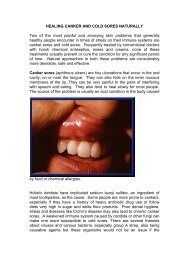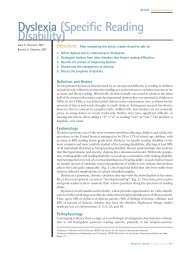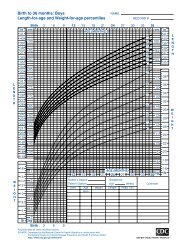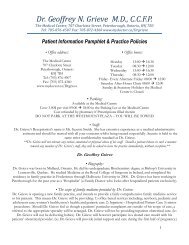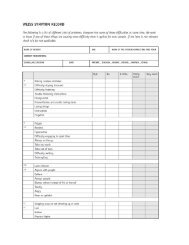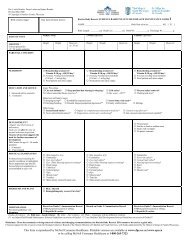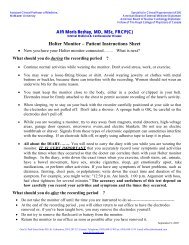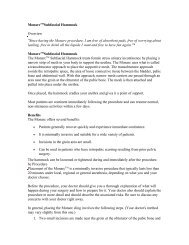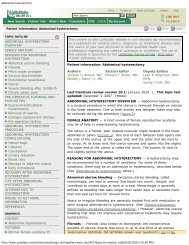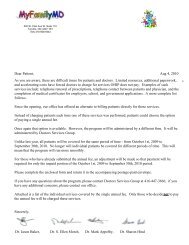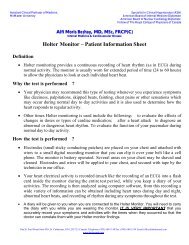Interstitial cystitis - Mydoctor.ca
Interstitial cystitis - Mydoctor.ca
Interstitial cystitis - Mydoctor.ca
Create successful ePaper yourself
Turn your PDF publications into a flip-book with our unique Google optimized e-Paper software.
INTERSTITIAL CYSTITIS<br />
<strong>Interstitial</strong> <strong>cystitis</strong> is a chronic condition <strong>ca</strong>used by<br />
inflammation of the space between the urinary bladder lining<br />
and the bladder muscle. There are a variety of <strong>ca</strong>uses but<br />
bacteria are generally not found in the bladders of victims and<br />
antibiotics are ineffective. This is in contrast to the more<br />
common bladder infections <strong>ca</strong>used by bacteria originating in<br />
the large bowel. It is important to get a urine culture done to<br />
determine if bacteria are present before starting antibiotic<br />
prescriptions. Bacteria may presensitize the bladder so that<br />
various promoters (certain drugs, foods, hormones and<br />
viruses) start the chronic disease process. <strong>Interstitial</strong> <strong>cystitis</strong> is<br />
a progressive disease which may range in severity from<br />
microscopic ulcers to a completely s<strong>ca</strong>rred bladder. <strong>Interstitial</strong><br />
<strong>cystitis</strong> is an environmentally induced illness which frequently<br />
responds to diet and lifestyle changes.<br />
Patients with interstitial <strong>cystitis</strong> <strong>ca</strong>n usually control symptoms<br />
of frequency, burning, painful intercourse and pelvic irritation<br />
by avoiding high acid forming foods foods and those that<br />
contain high amounts of tyrosine, tyramine and aspartate. Eat<br />
more of the alkaline forming foods. If symptoms improve,<br />
challenge oc<strong>ca</strong>sionally with low acid forming foods. See tables<br />
below for a guideline.<br />
HIGHEST ACID FORMING FOODS/CHEMICALS<br />
sugar/cocoa<br />
malt<br />
pudding/jams/jellies<br />
vinegar<br />
processed cheese<br />
ice cream<br />
beef<br />
pheasant<br />
lobster<br />
antibiotics<br />
cottonseed meal
hazelnut<br />
walnut<br />
brazil nut<br />
fried foods of any kind<br />
barley<br />
soybeans<br />
<strong>ca</strong>rob<br />
HIGHER ACID FORMING FOODS/CHEMICALS<br />
nutmeg<br />
aspartame<br />
yeast/hops/beer/wine<br />
psychotropic drugs<br />
saccharin<br />
<strong>ca</strong>sein (milk protein)<br />
cheeses<br />
soy milk<br />
veal<br />
pork<br />
chicken<br />
crustacea<br />
pistachio seed<br />
chestnut oil<br />
lard<br />
pe<strong>ca</strong>n<br />
palm kernal oil<br />
maize<br />
barley groats<br />
corn<br />
rye<br />
oat bran<br />
green pea<br />
peanut<br />
snow pea<br />
legumes<br />
<strong>ca</strong>rrots<br />
chock peas<br />
cranberry
pomegranate<br />
LOW ACID FORMING FOODS/CHEMICALS<br />
vanilla<br />
benzoate<br />
black tea<br />
alcohol<br />
antihistamines<br />
tapio<strong>ca</strong><br />
balsamic vinegar<br />
cow milk<br />
aged cheese<br />
goat milk<br />
lamb<br />
goose<br />
turkey<br />
shell fish<br />
almond oil<br />
sesame oil<br />
<strong>ca</strong>shew oil<br />
safflower oil<br />
seitan<br />
buckwheat<br />
wheat<br />
spelt/teff<br />
farina/semolina<br />
white rice<br />
tofu<br />
pinto beans<br />
white beans<br />
navy/red beans<br />
azuki beans<br />
lima beans<br />
chard<br />
plum<br />
prune<br />
tomatoes
LOWEST ACID FORMING FOODS/CHEMICALS<br />
curry<br />
MSG<br />
coffee<br />
honey/maple syrup<br />
rice vinegar<br />
cream<br />
yogurt<br />
goat cheese<br />
sheep cheese<br />
eggs<br />
gelatin<br />
wild duck<br />
venison<br />
fish<br />
pumpkin seed oil<br />
grape seed oil<br />
pine nut<br />
<strong>ca</strong>nola oil<br />
triti<strong>ca</strong>le<br />
milet<br />
kasha<br />
amaranth<br />
brown rice<br />
spinach<br />
fava beans<br />
kidney beans<br />
string/wax beans<br />
chutney<br />
rhubarb<br />
guava<br />
pickled fruit<br />
pineapple<br />
figs<br />
petrsimmon juice<br />
cherimoya<br />
dates
LOWEST ALKALINE FORMING FOODS/CHEMICALS<br />
sulfite<br />
ginger tea<br />
algae<br />
su<strong>ca</strong>nat<br />
umeboshi vinegar<br />
ghee (clarified butter)<br />
human milk<br />
avo<strong>ca</strong>do oil<br />
linseed oil<br />
coconut oil<br />
olive oil<br />
most seeds<br />
oats<br />
grain coffee<br />
quinoa<br />
wild rice<br />
brussel sprout<br />
beet<br />
chive/cilantro<br />
okra<br />
turnip greens<br />
squashes<br />
lettuces<br />
ji<strong>ca</strong>ma<br />
apricot<br />
banana<br />
blueberry<br />
currant<br />
raisin<br />
grape<br />
strawberry<br />
LOW ALKALINE FORMING FOODS/CHEMICALS<br />
ginseng<br />
green tea<br />
mu tea
sake<br />
rice syrup<br />
apple cider<br />
primrose oil<br />
sesame seed oil<br />
cod liver oil<br />
almond<br />
sprouts<br />
potato<br />
bell pepper<br />
mushroom<br />
fungi<br />
<strong>ca</strong>uliflower<br />
rutabaga<br />
eggplant<br />
pumpkin<br />
collard green<br />
pear/avo<strong>ca</strong>do<br />
pineapple juice<br />
apple<br />
blackberry<br />
cherry<br />
peach<br />
papaya<br />
MORE ALKALINE FORMING FOODS/CHEMICALS<br />
spices<br />
sea salt<br />
mineral water<br />
grain beverage<br />
molasses<br />
soy sauce<br />
poppy seed<br />
cinnamon<br />
chestnut<br />
pepper<br />
ginger root<br />
kohlrabi
parsnip<br />
garlic<br />
kale<br />
parsley<br />
endive<br />
mustard green<br />
taro<br />
broccoli<br />
<strong>ca</strong>nteloupe<br />
honeydew<br />
citrus<br />
olive<br />
loganberry<br />
mango<br />
MOST ALKALINE FORMING FOODS/CHEMICALS<br />
baking soda<br />
table salt<br />
umeboshi plums<br />
wakame<br />
burdock<br />
hydrogenated oil<br />
lentils<br />
yam<br />
nori/kombu<br />
onion<br />
daikon<br />
other sea vegetables<br />
sweet potato/yam<br />
nectarine<br />
persimmom<br />
raspberry<br />
watermelon<br />
tangerine<br />
Foods high in tyrosine, tyramine, tryptophan and aspartate<br />
include: beer, brewer’s yeast, <strong>ca</strong>nned cheeses, chicken livers,<br />
chocolate, corned beef, mayonnaise, aspartame, pickled
herring, saccharine, sour cream, soy sauce, wines and<br />
vitamins or minerals buffered with aspartate. It is also possible<br />
that hidden allergies to wheat, milk and other commonly eaten<br />
foods may <strong>ca</strong>use recurrent bladder irritation.<br />
Stress in general worsens symptoms of interstitial <strong>cystitis</strong> in<br />
many <strong>ca</strong>ses. Meditation, relaxation and various forms of<br />
psychotherapy may be very helpful. Drugs that may be<br />
promoters of the disease include over-the-counter cold<br />
medicines and some long-lasting cough drops. Amphetaminelike<br />
diet pills may also be involved.<br />
Cranberry juice and vitamin C supplementation may be very<br />
helpful in the treatment of acute bacterial bladder infections<br />
but make interstitial <strong>cystitis</strong> symptoms worse. Instead, take 1-<br />
2 tsps. of sodium bi<strong>ca</strong>rbonate powder in water every 4 hours<br />
as needed for pain relief. Sodium bi<strong>ca</strong>rbonate alkalinizes the<br />
urine and prevents acids from interacting with sore and<br />
damaged tissues. Also, take about 500 mgs. of <strong>ca</strong>lcium<br />
<strong>ca</strong>rbonate every 6 hours. This helps in alkalinizing the urine.<br />
Drink lots of clear fluids, especially water, since diluting the<br />
urine prevents harmful elements from interacting with<br />
damaged tissue. Also, experiment with ice packs or heating<br />
pads to see which helps best.<br />
Supplemental vitamins and minerals that may be very helpful<br />
in the treatment of interstitial <strong>cystitis</strong> include vitamin A, beta<br />
<strong>ca</strong>rotene, vitamin B6, <strong>ca</strong>lcium ascorbate (a buffered form of<br />
vitamin C), vitamin D, vitamin E , essential fatty acids like<br />
primrose oil, flax seed oil and borage, <strong>ca</strong>lcium, magnesium,<br />
selenium, cysteine, cystine, glutathione, methionine, PABA<br />
(para-aminobenzoic acid), taurine and dimethyl glycine (DMG).<br />
Although this may seem like an awesome list of vitamin and<br />
mineral supplements, many companies have most of these<br />
available in 3 or 4 combination products available at most<br />
health food stores.<br />
Try the dietary restrictions and the vitamin and mineral<br />
supplements for at least one month to see if symptoms come
under better control. Consult a nutrition oriented health <strong>ca</strong>re<br />
practitioner for appropriate supplementation dosages,<br />
supervision and follow up.



